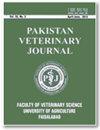Study of Oxidative Stress and Histo-Biochemical Biomarkers of Diethyl Phthalate Induced Toxicity in a Cultureable Fish, Labeo rohita
M. Latif, M. Faheem, Asmatullah
求助PDF
{"title":"Study of Oxidative Stress and Histo-Biochemical Biomarkers of Diethyl Phthalate Induced Toxicity in a Cultureable Fish, Labeo rohita","authors":"M. Latif, M. Faheem, Asmatullah","doi":"10.29261/pakvetj/2019.108","DOIUrl":null,"url":null,"abstract":"Received: Revised: Accepted: Published online: September 09, 2019 October 12, 2019 October 13, 2019 October 19, 2019 Diethyl phthalate (DEP) is a widely used low-molecular weight phthalate which is ubiquitously detected in almost all kind of the environmental matrices. The aim of the present study was to investigate the impact of DEP-induced toxicity on a suite of biomarker responses in Labeo rohita (rohu). The median lethal concentration of DEP was found to be 4.38 mg L for 96 h. Fingerlings were exposed to a sub-lethal concentration of DEP i.e. 0.51 mg L(1/10 LC50) for a period of 21 day of the experiment. Oxidative stress and histo-biochemical biomarkers were studied using gills, liver, kidney and brain tissues on 7, 14 and 21 day. The results indicated that DEP-exposure has damaged the antioxidant status by inhibiting the activities of enzymatic stress markers (catalase, glutathione-s-transferase, glutathione peroxidase, reduced glutathione) in all the studied tissues of rohu throughout the study period. Moreover, a significant increase in the levels of lipid peroxidation was observed in all the studied tissues in a time-dependent manner. The levels of hepatic-nephric biomarkers (ALT, AST, ALP, Urea and Creatinine) were found to be significantly elevated for DEP-exposed rohu when compared to control (P<0.05) throughout the study period. The histopathological marker showed severe lesions in the gills (hypertrophy, fusion and curling of lamellae,), liver (pyknotic nuclei, leukocytes infiltration and vacuolization) and kidney tissues (glomerulus expansion, narrowing and elongation of renal tubules) of DEP-exposed rohu. In conclusion, the above mentioned histo-biochemical parameters could be used as biomarkers for DEP toxicity monitoring in the aquatic ecosystem. ©2019 PVJ. All rights reserved","PeriodicalId":19845,"journal":{"name":"Pakistan Veterinary Journal","volume":" ","pages":""},"PeriodicalIF":5.4000,"publicationDate":"2020-04-01","publicationTypes":"Journal Article","fieldsOfStudy":null,"isOpenAccess":false,"openAccessPdf":"","citationCount":"27","resultStr":null,"platform":"Semanticscholar","paperid":null,"PeriodicalName":"Pakistan Veterinary Journal","FirstCategoryId":"97","ListUrlMain":"https://doi.org/10.29261/pakvetj/2019.108","RegionNum":3,"RegionCategory":"农林科学","ArticlePicture":[],"TitleCN":null,"AbstractTextCN":null,"PMCID":null,"EPubDate":"","PubModel":"","JCR":"Q1","JCRName":"VETERINARY SCIENCES","Score":null,"Total":0}
引用次数: 27
引用
批量引用
Abstract
Received: Revised: Accepted: Published online: September 09, 2019 October 12, 2019 October 13, 2019 October 19, 2019 Diethyl phthalate (DEP) is a widely used low-molecular weight phthalate which is ubiquitously detected in almost all kind of the environmental matrices. The aim of the present study was to investigate the impact of DEP-induced toxicity on a suite of biomarker responses in Labeo rohita (rohu). The median lethal concentration of DEP was found to be 4.38 mg L for 96 h. Fingerlings were exposed to a sub-lethal concentration of DEP i.e. 0.51 mg L(1/10 LC50) for a period of 21 day of the experiment. Oxidative stress and histo-biochemical biomarkers were studied using gills, liver, kidney and brain tissues on 7, 14 and 21 day. The results indicated that DEP-exposure has damaged the antioxidant status by inhibiting the activities of enzymatic stress markers (catalase, glutathione-s-transferase, glutathione peroxidase, reduced glutathione) in all the studied tissues of rohu throughout the study period. Moreover, a significant increase in the levels of lipid peroxidation was observed in all the studied tissues in a time-dependent manner. The levels of hepatic-nephric biomarkers (ALT, AST, ALP, Urea and Creatinine) were found to be significantly elevated for DEP-exposed rohu when compared to control (P<0.05) throughout the study period. The histopathological marker showed severe lesions in the gills (hypertrophy, fusion and curling of lamellae,), liver (pyknotic nuclei, leukocytes infiltration and vacuolization) and kidney tissues (glomerulus expansion, narrowing and elongation of renal tubules) of DEP-exposed rohu. In conclusion, the above mentioned histo-biochemical parameters could be used as biomarkers for DEP toxicity monitoring in the aquatic ecosystem. ©2019 PVJ. All rights reserved
邻苯二甲酸二乙酯对养殖鱼氧化应激及毒性组织生化生物标志物的研究
接收:修订:接受:在线发布:2019年9月9日2019年10月12日2019年12月13日2019年11月19日邻苯二甲酸二乙酯(DEP)是一种广泛使用的低分子量邻苯二酯,在几乎所有类型的环境基质中都普遍检测到。本研究的目的是研究DEP诱导的毒性对Labeo rohita(rohu)一系列生物标志物反应的影响。发现DEP的中位致死浓度为4.38 mg/L,持续96小时。将手指暴露于亚致死浓度的DEP,即0.51 mg/L(1/10 LC50),持续21天的实验。在第7、14和21天,使用鳃、肝、肾和脑组织研究氧化应激和组织生化生物标志物。结果表明,在整个研究期间,DEP暴露通过抑制罗湖所有研究组织中的酶应激标记物(过氧化氢酶、谷胱甘肽-s-转移酶、谷胱甘肽过氧化物酶、还原型谷胱甘肽)的活性,损害了罗湖的抗氧化状态。此外,在所有研究的组织中都观察到脂质过氧化水平以时间依赖的方式显著增加。在整个研究期间,与对照组相比,暴露于DEP的rohu的肝肾生物标志物(ALT、AST、ALP、尿素和肌酐)水平显著升高(P<0.05)。组织病理学标志物显示暴露于DEP的rohu的鳃(片层肥大、融合和卷曲)、肝脏(固缩细胞核、白细胞浸润和空泡化)和肾组织(肾小球扩张、肾小管狭窄和延长)出现严重病变。总之,上述组织生化参数可作为水生生态系统DEP毒性监测的生物标志物。©2019 PVJ。保留所有权利
本文章由计算机程序翻译,如有差异,请以英文原文为准。


